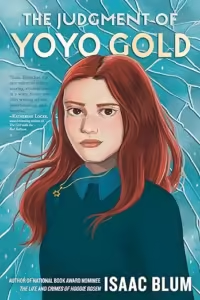The Judgment of Yoyo Gold
Isaac Blum
Philomel Books
Published October 15, 2024
Amazon | Bookshop | Goodreads
About The Judgment of Yoyo Gold
A smart and powerful story set in the Orthodox Jewish community about what it means to fit in, break out, and find your own way, by the award-winning author of The Life and Crimes of Hoodie Rosen. This book is Gossip Girl + My Name Is Asher Lev + I Am Not Your Perfect Mexican Daughter.
Yoyo Gold has always played the role of the perfect Jewish daughter. She keeps kosher, looks after her siblings, and volunteers at the local food bank. She respects the decisions of her rabbi father and encourages her friends to observe the rules of their Orthodox faith. But when she sees her best friend cast out of the community over a seemingly innocent transgression, Yoyo’s eyes are opened to the truth of her neighbors’ hypocrisies for the first time. And what she sees leaves her shocked and unmoored.
As Yoyo’s frustration builds, so does the pressure to speak out, even if she can only do so anonymously on TikTok, an app that’s always been forbidden to her. But when one of her videos goes viral—and her decisions wind up impacting not only her own life but also her relationship with the boy she’s falling for—Yoyo’s world is thrown into chaos. She is forced to choose which path to take, for her community, for her family, and most importantly, for herself.
Award-winning author Isaac Blum returns with a new novel that asks what it really means to be part of a community—and what it means to break free.
My Review
I feel like this is one of those books whose sum is greater than its parts. It’s a girl’s exploration of her faith and what it means to her. It’s a dry, funny story about growing up and falling in love.
One of my favorite things about the book is all the moments in which Yoyo responds to a situation with some unexpected, funny aside. Sometimes it’s a quick after-the-fact joke. Those moments consistently took me by surprise and added levity to the scene.
I also like how much of the story centers around female relationships with one another and the power of those connections to protect or destroy. The girls could be cruel to one another. In a close community like Yoyo’s, rumors could be devastating. But that same close community meant that girls holding space for one another and offering support or understanding also had a huge impact.
At this point, I think we’ve all read books about faith deconstruction in which the main character grows up and discards the beliefs and values they were raised to hold. The message is usually something along the lines of exposing hypocrisy and casting off faith which held one back from living a fuller, more authentic life.
This isn’t that story. It’s frank in its assessment of the strictures of the Orthodox faith. Yoyo’s questions are genuine, and her struggle is real. But it isn’t a binary question of whether she will embrace her faith or discard it. Her path forward isn’t simple, but it does lead her toward greater authenticity and a greater understanding of what her role in her family and community and her faith mean to her.
I can tell I’m going to be thinking about this book for a long time, and I’m really excited to read more by Isaac Blum. I have his debut novel, but hadn’t gotten to it yet. I’m going to have to fix that very soon!
Readers who enjoy faith exploration or stories about someone’s journey toward a more authentic life will want to read this one.
Content Notes for The Judgment of Yoyo Gold
Recommended for Ages 14 up.
Representation
Most characters are Jewish. One of Yoyo’s friends is Korean American and Jewish.
Profanity/Crude Language Content
A very small number of swear words.
Romance/Sexual Content
Kissing between boy and girl. References to touching over clothes.
Spiritual Content
Yoyo is part of an Orthodox community and adheres to strict faith practices and beliefs. Through the story she explores her relationship with her faith and with those rules. Is she doing things because she wants to or because it’s expected? Does she agree with the values of the community? What happens when someone breaks the rules? The story references Shabbos services, holidays, and other Jewish traditions.
Violent Content
Some references to antisemitic comments on Yoyo’s social media. Reference to sexually violent comments. (Yoyo doesn’t repeat what commenters said, only that it’s explicit and violent.)
Drug Content
Yoyo and other teens drink alcohol at a party. Yoyo sees someone using a vape pen.
Note: This post contains affiliate links, which do not cost you anything to use but help support this blog. I received a free copy of this book in exchange for my honest review. All opinions are my own.
